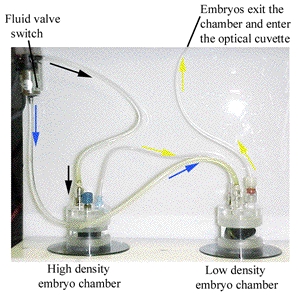 |
||||||
Embryo Chambers |
||||||
| Optics Cuvette | ||||||
| Optics Chamber | ||||||
| Sorting Switch | ||||||
| Assembly | ||||||
| Electronics | ||||||
| System Timing | ||||||
| Computer Display | ||||||
| Parts List | ||||||
| Contacts | ||||||
Embryo Sorter Website Eileen Furlong, David Profitt, Matthew Scott |
Embryo Chambers
In order to maintain a constant sorting rate (embryos/sec.), we used a two-chamber system, a high-density embryo chamber, and a low-density embryo chamber.
Picture of Embryo Chambers

Collected embryos are initially added to the high-density chamber. Solution is pumped into the low-density chamber (blue arrows) and then moves through the exit tube to the optical cuvette. If the sorting rate drops below a defined threshold, the computer sends a signal to a fluid valve. This fluid valve then diverts the fluid flow to the high-density chamber (black arrow). Fluid will then leave this chamber and enter into the low-density chamber, resulting in the addition of embryos to the low-density chamber. When the rate of embryo sorting increases to the defined threshold, the computer will send a signal back to the valve and re-direct the fluid flow to the low-density embryo chamber. This will stop the addition of more embryos. The sorting switch that we are currently using can open and close in ~10 ms, giving a theoretical sorting speed of approximately 100 embryos per second. However, we have empirically determined the optimal sorting rate to be 15 embryos per second under present conditions.The chambers were fabricated from clear Acrylic plastic (Link to picture).
The dimensions of the chambers are as follows:
Measurement \ Chamber High Density chamber Low Density chamber Internal diameter 1.1875" 1.1875" Height 1.1875" 1.5" Capacity with the stir-bar 9ml 18ml All fluid flow tubing is micro-bore Polyvinylchloride with an inside diameter of 0.030".